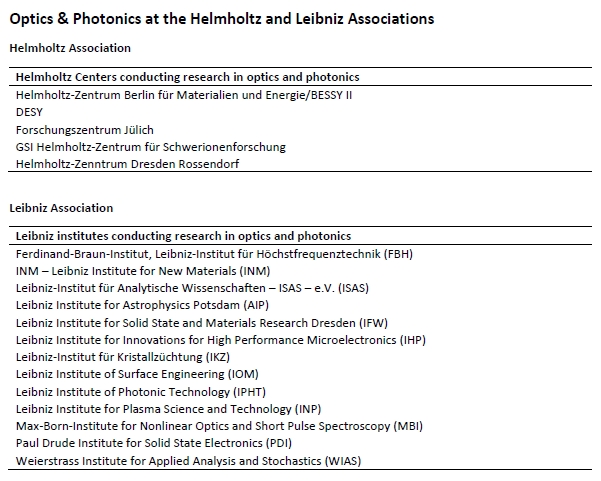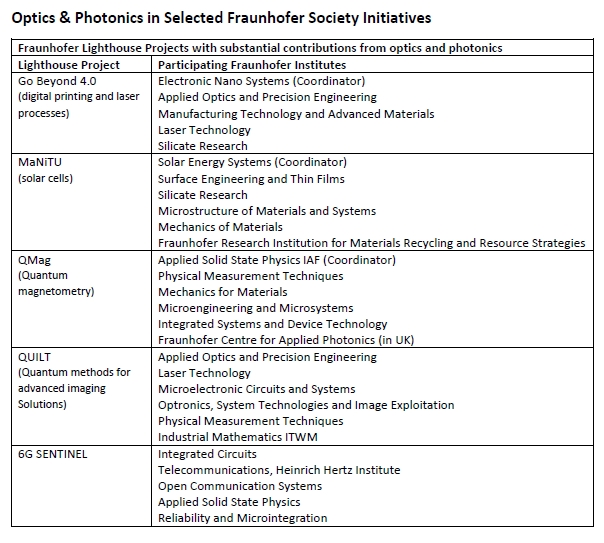![]()
[Image: peterschreiber.media/Getty Images]
This is the final article in a four-part series describing public research funding in Germany. Claus Roll is a director of research and program development for OSA Europe.
In previous articles in this series, we’ve reported on the overall picture for public research funding of optics and photonics in Germany, and offered a closer look at support of the optics and photonics domain by two of the country’s most significant public funding providers, the German Research Foundation (DFG) and the Federal Ministry of Research and Education (BMBF). The picture that has emerged thus far is something of a mosaic, as different programs break out optical technologies differently, and some do not break them out at all.
For example, as reported in the first story, the BMBF lists total German government funding of “optical technologies” at about €245 million. That number, however, is almost certainly an underestimate, as optics also shows up in a broad range of other technology domains. In contrast, the deeper dive, in the second and third stories, into several DFG and BMBF initiatives in which photonics plays a role revealed an opposite pattern. For these two funding bodies, a total of around €250 million, spread across five funding initiatives, likely overestimates the amount spent on optics and photonics under those initiatives, which also include funding in other domains.
There is, however, one other important, and highly distinctive, source of public research funding for optics and photonics in Germany: the country’s four major research organizations, including the Helmholtz Association, the Leibniz Association, the Fraunhofer Society and the Max Planck Society. In this last story in our series, we focus on optics and photonics funding by the first three of those four organizations. (For Max Planck, research budgets are available only at the level of the overall society, not at the level of individual institutions, and the assumptions and approximations necessary to pick apart the rough photonics contribution lie beyond the scope of what we’ve attempted here.)
Base versus contract
Before diving into the details, a first-order distinction among the four German research associations is worth noting. For three of the four—the Helmholtz Association, the Leibniz Association and the Max Planck Society—a majority of the budget comes from public-sector base/institutional (that is, non-contract) funding. The situation is completely the opposite for the Fraunhofer Society, where the larger share comes from contract research funding, also called third-party funding.
The relative importance of longer-term, base funding commitments at the first three associations lies in their need for heavy, long-term investments into basic research or large-scale infrastructure. In contrast, the timescale of projects carried out at Fraunhofer institutes is usually shorter (with some exceptions), and tends to concern applied research, with industry both as a collaborator and a “customer.” In describing its approach to research, the Fraunhofer Society says: “The essence of our research portfolio is formed by widely diverse issue-oriented and problem-driven research questions that are approached in an interdisciplinary and networked manner, with a constant focus on rapid transfer.”
Helmholtz and Leibniz
The Helmholtz Association’s budget is approximately €5 billion annually. The association runs some 20 research centers across Germany, including large-scale infrastructure centers such as BESSY II in Berlin and DESY in Hamburg; other facilities in Jülich, Rossendorf and elsewhere; and German Aerospace Center in Köln, with its own network of research centers.
Optics and photonics research is conducted at many of the Helmholtz centers, but detailed funding figures are available only at the research center level, with no possibility of reducing the figures further to the contributions in optics and photonics. (See the accompanying tables for lists of Helmholtz and Leibniz institutes participating in optics and photonics research.)
The 96 institutes across Germany that are affiliated with the Leibniz Association conduct basic and applied research, with 13 specifically conducting research in optics and photonics. The association’s total budget weighs in at €1.889 billion, with public-sector institutional base funding representing €1.224 billion of the total and third-party or contract funding another €0.478 billion.
The annual reports of the 13 Leibniz institutes partly or fully devoted to optics and photonics research show total institutional base funding of €196 million and third-party funding of €92.76 million. Of the latter, 88% comes from public-sector contract funding and only 12% from industry contracts—a notable difference from the pattern at Fraunhofer.
The Fraunhofer Society
The Fraunhofer Society conducts applied research, bringing ideas and technologies from academia to industry via 74 institutes in Germany. Optics and photonics are present in the Fraunhofer Society at different levels of its internal structures.
- Strategic research fields. Fraunhofer has defined seven strategic research fields, among them “Quantum Technologies,” “Communication and Knowledge,” and “Next-Generation Computing,” in which funding on optics and photonics research can be found.
- Lighthouse projects. These multidisciplinary research projects—carried out by consortia of several Fraunhofer institutes, each bringing its particular area of expertise—focus on technologies required by industry. Five Lighthouse projects have ties to optics and photonics (see accompanying table).
- Fraunhofer groups. Groups of Fraunhofer institutes also work on related topics and share their presence in the R&D market. The “Light & Surfaces” group is the one most directly related to optics and photonics; the “Microelectronics” group also boasts a strong optics and photonics presence. Together, these two groups involve 22 different institutes (see accompanying table)—though nearly all other Fraunhofer groups include one or more institutes that at least partly cover optics and photonics.
- Fraunhofer Clusters of Excellence. These units are set up to support long-term projects, bringing together know-how from different institutes within a single “virtual” institute. One example, the Fraunhofer Cluster of Excellence Advanced Photon Sources (CAPS), comprises the Fraunhofer Institute for Laser Technology in Aachen and the Institute for Applied Optics and Precision Engineering in Jena.
- Collaboration with other research organizations. Research Fab Microelectronics Germany is a collaboration of 11 of the institutes of the Fraunhofer Microelectronics group, with two institutes of the Leibniz Association contributing expertise in applied research, development and innovation in the micro- and nanoelectronics sector.
In 2019, the society’s total budget included €2.279 billion (83%) for contract research, €0.306 billion (11%) for infrastructure and €0.159 billion (6%) for long-term research.
Of the €2.279 billion in contract research, about €0.729 billion (32%) was from public-sector base funding and €1.549 billion (68%) from third-party (contract) funding. The substantial budget contribution of third-party, or contract, funding—much larger than for the other three research organizations—itself is split between public-sector contract funding (53% of total third-party funding) and industry contracts (47% of total third-party funding).
Once again: A partial picture
In the research institutes, as with German public-sector funding in general, some funding budgets can directly be linked to optics and photonics. For others, it’s impossible to infer from available reports how much research in optics and photonics contributes to total budgets.
Beyond absolute numbers, however, this final article in our series also shows the links between the strategic orientations of the different organizations, their funding patterns and sources (public versus industry), and the type of research carried out. That research varies from basic research needing huge, long-term or infrastructural investments, to applied research focused short- to intermediate-term results—objectives that also shape the relative contributions of public base funding and industry contract funding.


